I know I’m courting controversy here, but today I’m going to try to convince you that it’s GOOD that there isn’t standardized sizing in sewing patterns, or in ready-to-wear clothes from stores.

Now you may be thinking, “Jenny, don’t you know how hard it is when sizing is all over the place?!” and I totally get where you’re coming from, and before I became a sewing pattern designer I’d have agreed with you. Why oh why can’t I just be a size 18 in every pattern? Why am I a 16 in one, and a 20 in another? However, it’s actually a blessing in disguise.
In a nutshell: if all sewing patterns and clothing used the same measurements and same proportions for their sizing, then either you’d fit ALL of them, or you’d fit NONE of them.
And that means 90% of us would fit NONE!
Right now, because brands vary in both the measurements and proportions that they use, you stand a good chance of finding a brand that is very similar to your body, and therefore either fits, or with minimal adjustments. You know how often jeans from one store fit you but not at any others? You’ve found the one that has an underlying block design which matches your body. But if all brands used the same sizing, you wouldn’t fit in any.
There are two elements to this. First up, measurements. Each brand decides what set of measurements they’re going to use for each size—so for instance, in Cashmerette, an 18 is 46 – 48″ bust (depending on cup size), 38″ waist and 48″ hip. But, in another brand, it might be 45″, 39″, 50″. Depending on your measurements, you may find one of those is much closer to your bust-waist-hip ratio than another, and you’ve skipped a bunch of adjustments!
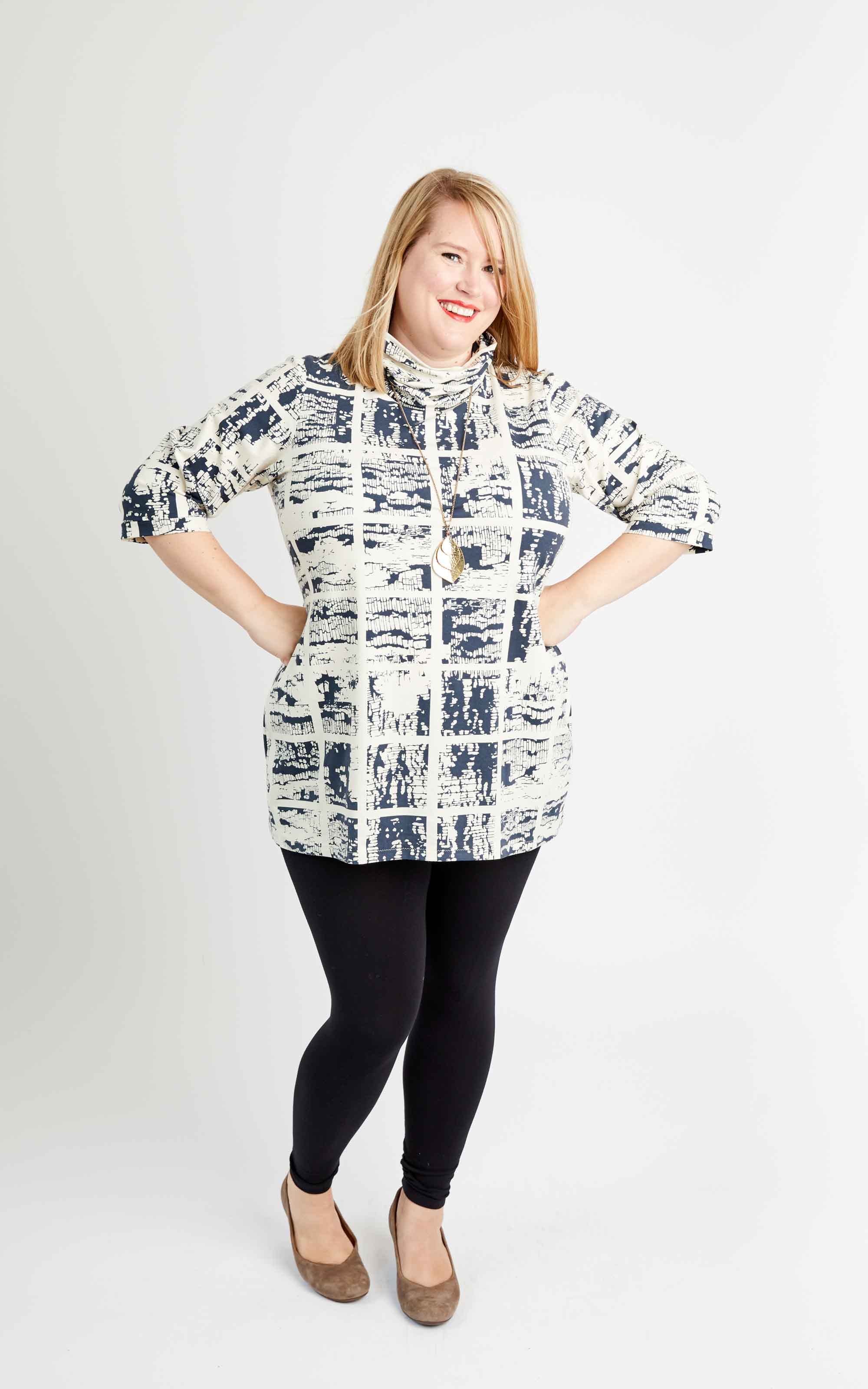
Jenny is wearing the Pembroke Dress and Tunic.
The second consideration is proportion. Cashmerette is designed for curvy bodies—that primarily means big boobs, but also a curve to the waist and hip, and a full tummy. So, if you’ve got big boobs, we’ve already drafted every seam and style line to work for your body type. As you can imagine, if all pattern sizing was the same, then either there would be no option like Cashmerette, or everything would have to be curvy! Luckily, different brands draft for different proportions: whether that’s long-waisted, or small busted, or straight up and down, or pear-shaped, or apple, or hourglass—you get the idea. To some extent you can tell that from the body measurement chart, but you can also ask the designer for more information if they don’t share it publicly.
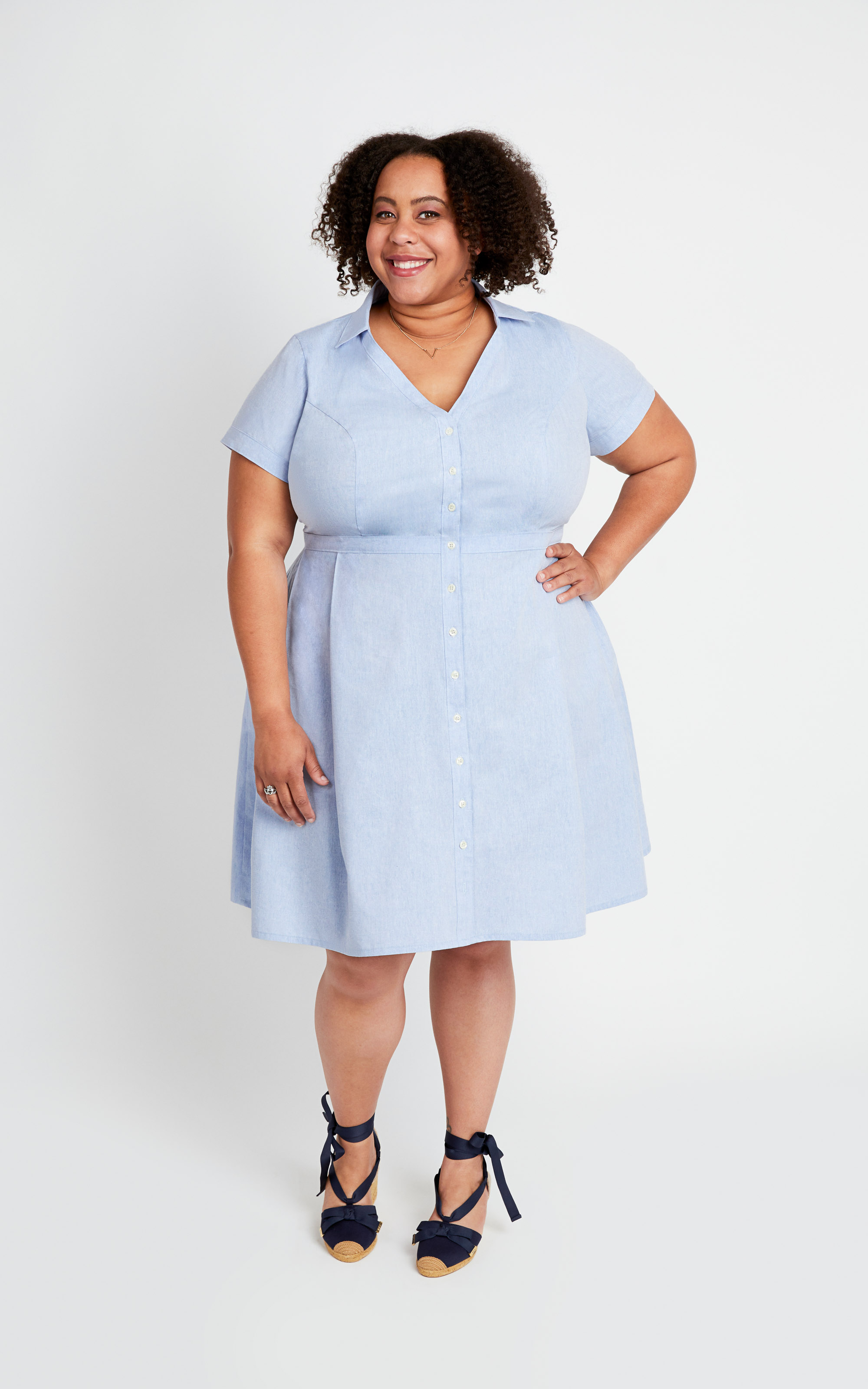
Sierra is wearing the Lenox Shirtdress.
The great news is as sewists, we have a shortcut to help us take good advantage of the variations in sizing. If you’re looking for jeans from a store, there’s no way to actually know what the measurements and proportions are of say J Crew jeans vs. GAP jeans, vs. Old Navy jeans. Nope, you have to trawl around the mall trying on umpteen pairs until you maybe find one that fits you. Which we all know is no one’s idea of a good time. However, as sewists, we know our measurements, and all sewing patterns (or any that are worth their salt) tell you the measurements for each size, and the better ones will also give you more details like the height and cup size they’re designing for. In fact, we’ve got a summary of the main sewing patterns for plus sizes right here with the measurements of the largest size and cup size to help you find patterns for your body even quicker.
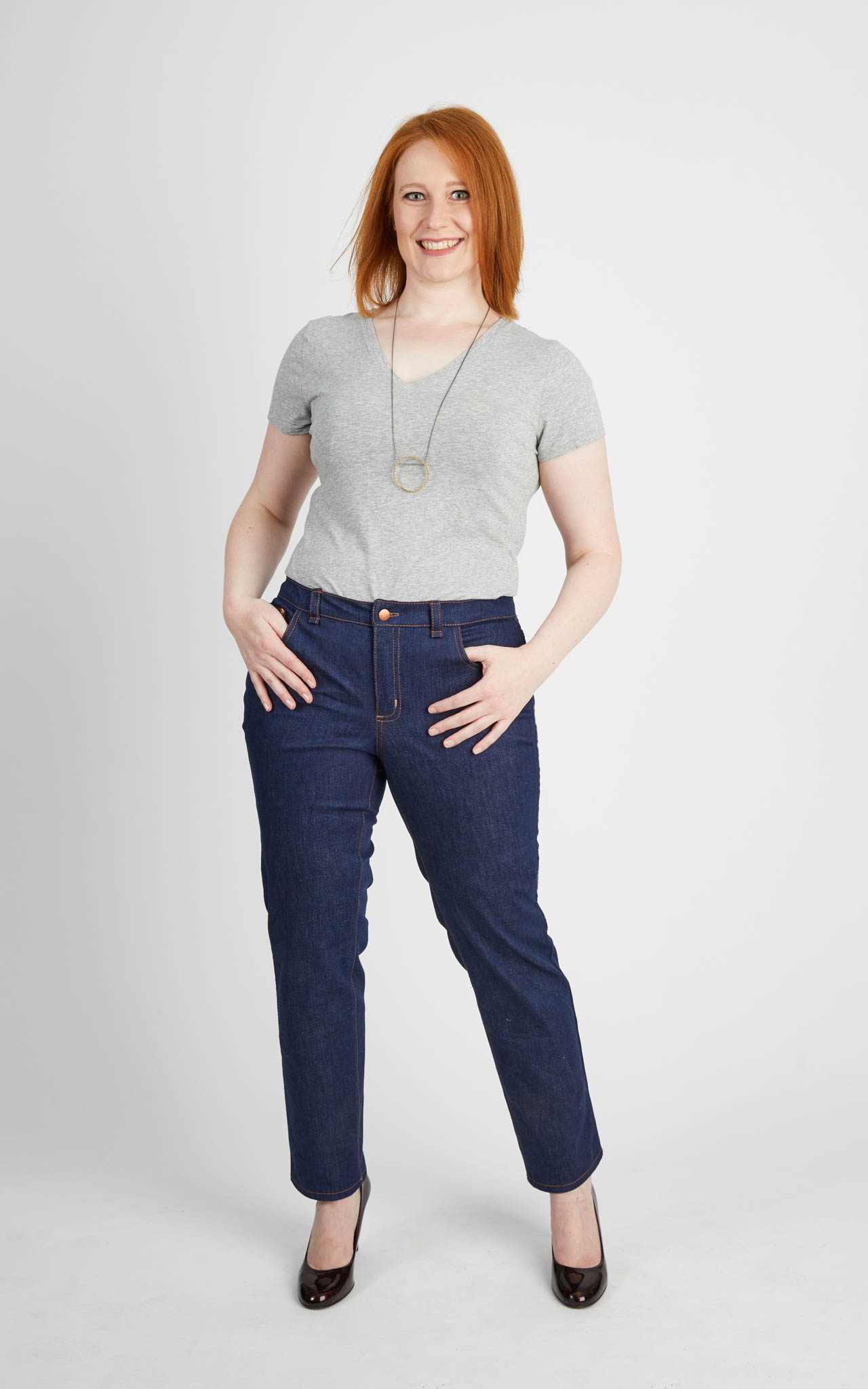
Dawn is wearing the Ames Jeans.
Have I convinced you? Our superpower as sewists is being able to create clothes that fit our bodies rather than trying to change our bodies, and variation in sizing is just another tool to help us achieve that as quickly as possible! Let me know whether you agree—or think I’ve lost the plot—below.

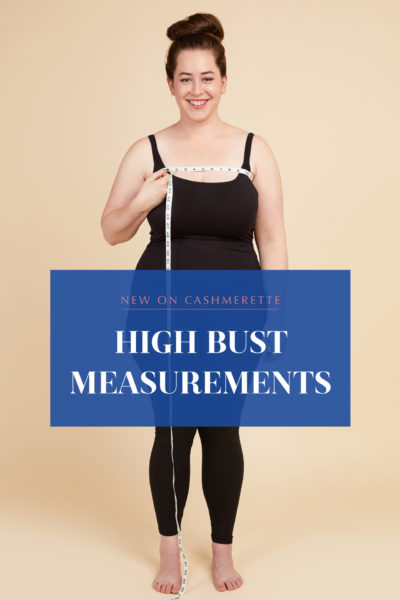
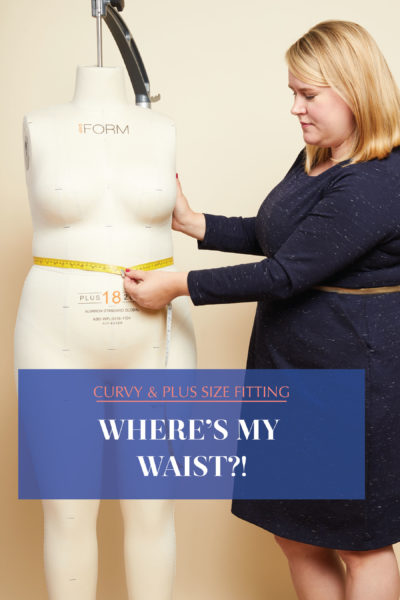
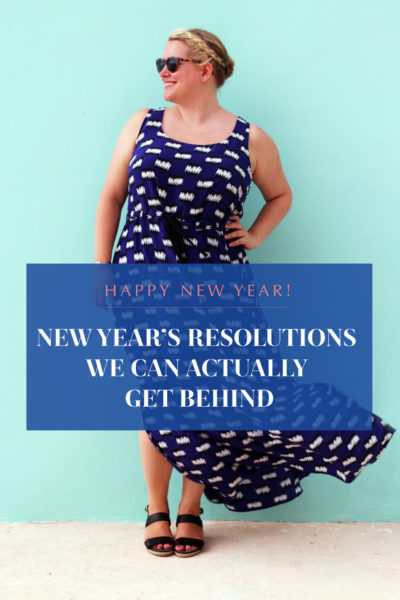

Jenny, You make SO much sense! That is the reason I began sewing 60 years ago at the ripe old age of 6! When I was 12, I was 5’10” tall and weighed about 125#! My how things have changed. But even being tall and slender I could not find patterns that fit! I did not have the experience to know how to adjust patterns either. Hence a 4 year degree in Fashion Design! Though I could draft or drape any garment I want, having curvy patterns available to perfect the fit and use as a sloper for any style imaginable is so much quicker and better fitting. Thank you for all you do to help curvy home sewists get a good fit through your patterns and excellent pattern adjustment instructions!
Jenny, you are right on the mark! I have been sewing for fifty years through various body shapes and when you find the
pattern line that is drafted for your shape it is truly like finding the holy grail! Your patterns are perfect for me and I love
just pulling one out and sewing with the anxiety of fitting issues. The armscyes and bust are always perfect. I have all of
your patterns and look forward to purchasing new additions to your line as they appear. Thank you for your perfectly
wonderful designs. They make sewing such a treat!
Jenny, I meant to say sewing WITHOUT the anxiety of fitting issues.. sorry
I totally agree with the concept. No two bodies are alike, even curvy bodies. I do however find that Cashmerette patterns need far fewer adjustments for my body shape and depth than any of the others on the market, and believe me, I have tried most! I love the modern yet classic designs too, giving access to to many variations and incredibly different looks. After taking time to do a proper wardrobe and body analysis I have gradually built up a whole new wardrobe over the last few years and equally gradually, rid myself of everything that I owned before I discovered myself (and Cashmerette)! I now have beautiful dresses, coats, jeans, trousers, tops, winter wear, skirts, cardigans,and swimwear. All from a few patterns, all from carefully chosen beautiful fabrics of my own choice, and all that fit and flatter my unique shape. Not only that but I can honestly say I have enjoyed my journey and learned so much more along the way. Jenny, you have literally changed my life so THANK YOU🙏 x
I think it is great when you find a brand of clothes that fit and you can just trust the sizing. I really don’t need a thousand brands that are the same size. I love that brand X fits me while brand Y fits my sister. I find Cashmerette patterns fit really well and thus the numerous patterns I own. I find I need far fewer adjustments with Cashmerette. I teach fitting first when I teach sewing and yet I find the fewer adjustments needed the better. Why reinvent the wheel is the wheel is fitting the cart so well? Anyway, different brands with different sizing–you bet!
When i sew to my measurements for tops, 44 1/2, 44, 44 1/2, the tops come out about two sizes too big. When i look at pants patterns my waist is a 28 and my hips a 16. And, there aren’t any boobs just a rectangle. How do you make it work?????
Hi Deb – the key thing for you will be grading between sizes, because as far as I’m aware there aren’t any existing pattern companies right now that are already made for your proportions. Grading up the waist is often pretty easy – we have a whole guide here: https://www.cashmerette.com/pages/grading-between-sizes
I have basically given up on sewing for myself. With 7 granddaughters I’ve kept myself busy. And so, I began shopping and adjusting almost everything I bought, with shortening of pants legs and adding an additional dart to armholes etc. I couldn’t afford their tailoring fees and I can sew well enough to take something apart and adjust it to fit me. But, it was a pain. One day I happened into a Talbots store and discovered that size 14, petite fit me perfectly. I could try it on and walk out the door with something that fit. BUT….they are expensive. Then I discovered your website and ordered one of your patterns [the Upton dress]. I have to admit I haven’t used it yet but this blog has made realize why nothing fit me before and given me the courage to try your pattern. I’m going to take a look at your “Fitting for curves” online class and give it a try. Wish me luck!
I was willing to be convinced, but you lost me at the part about how there would be no Cashmerette if there were standard sizing. You would still be here because you have a particular vision and style and understand about using a different basic block for different sizes. And boobs.
I’ve been sewing for myself and others (sometimes family, sometimes actual clients) for years, I would KILL for standard sizing in patterns.
Men’s clothing and patterns are mostly standard sizing, (except when higher end brands invent their own to be ‘cool’). It’s always been easier to make alterations for clients for men’s clothes because the standard sizing proportions are the same and I know what I have to do. I can make a pattern fit out of the box for a guy without a toile because I’m only altering for the individual differences from the ‘norm’ (and yes, there is no actual norm). It’s a lot less work in the end.
Bodies are not standard sizes, and will always need alterations to make the clothes fit perfectly. That’s why people sew.
And don’t get me started on lumber: a 2×4 is actually 1.5″ x 3.5″. WHY?????
I can answer this one… There’s a long complex history to this, but in a nutshell 2 x 4 referred to the rough cut of lumber straight off the tree. Of course, wood shrinks as it dries and as we moved from an economy where wood came from local sources to wood being shipped from across the country to build your house, there was also a demand that the wood be finished, i.e., that the rough cut be straightened (“planed”) so it’s ready for use. As you can imagine, all kinds of “irregularities” happened. So after WWII regulations were put in place that stated that a rough cut 2×4 had to be 1.5″ x 3.5″ by the time it hit the lumberyard for sale.
As far as clothing sizes are concerned, I agree that I would love to have women’s sizing be by measurements rather than the ridiculous number system.
Cashmerette drafts for a curvy body, right? Let’s say we have two women whose bust measurement were both 46″. One woman is an athletic swimmer with breasts that protrude 4″ from the chest wall and large back muscles. The other has breasts that protrude 8″ from the chest wall with a narrow back. If Cashmerette had to draft just one pattern to “fit” the standardized measurements, which woman would it fit? Neither! Now try to take into account each of those womens’ waist, high hip, hip, buttocks shape, thighs, upper arms etc. Then try to fit those women into any pattern that had to adhere to standardized measurements. If every pattern company adhered to a size 20 having a 16″ upper arm, where would that leave the woman whose measurements all match at the bust, waist, and hip bit had larger upper arms?
I found this fascinating and read many responses (mostly on Instagram) that both agree and disagree, ready to be swayed if I found an argument that changed my mind. In the end I wholeheartedly agree! If sizing were standard nothing would fit most. Or the cost of patterns would be prohibitive if a pattern maker had to try to accommodate all body shapes and one would need a personal fitting session with the pattern maker to determine which version was the best fit for your shape. Add to that, people prefer different ease and fit. Definitely find one that fits the best and make your adjustments. Once you get that down maybe try another ‘not so close to my body shape’ pattern and see if you can get that to fit. Any garment can be a size 2, if that’s the label you sewed in.
I am just getting started with your patterns.Delighted to have found you. Will you make a huge announcement when the fitted blazer pattern is ready? Looks wonderful
Absolutely! Our progress on the blazer pattern has been slowed a bit by the pandemic but we are eager to get it out to the world!
-Ayelet at Cashmerette
Never heard of cashmerette patterns. Where can I find them ?
You’re on the website right now 🙂 Just click on “shop” at the top of the page.
It literally takes an act of Congress to change the standard of measurements. This is why the average woman’s height is measured wearing heels, and is 5′ 2″. ( The standard measurements were also calculated when women wore girdles! Nobody wants to go back there. That is why I have had to lengthen every pattern I’ve ever bought, and had to calculate new yardage to compensate.
Fit varies with size as well. +/- 1″ for small sizes, +/- 2″ for large sizes. For the large size, there could be a difference of 4″ between you and your size!